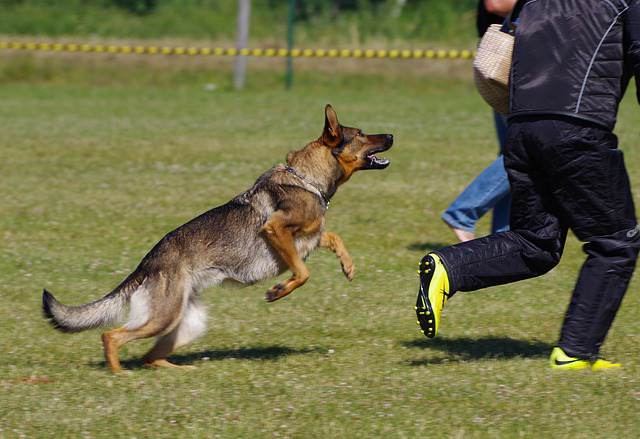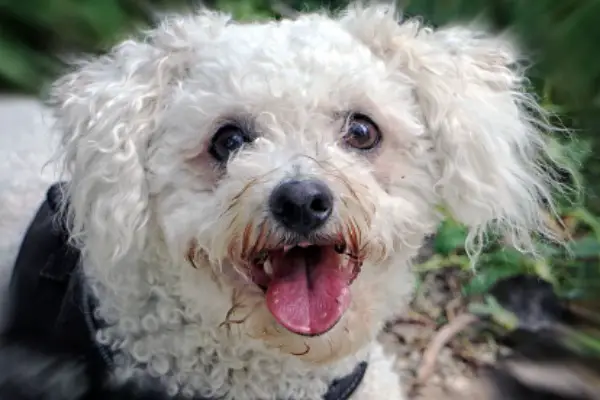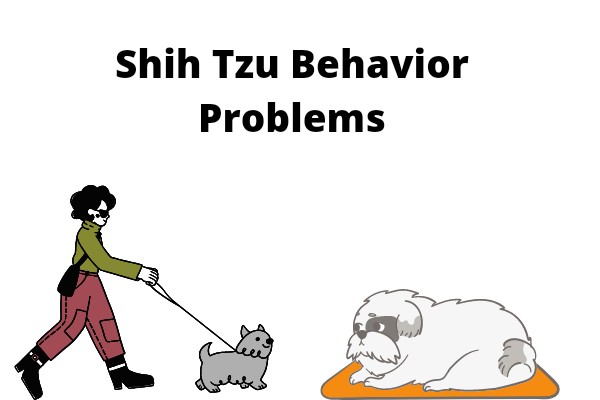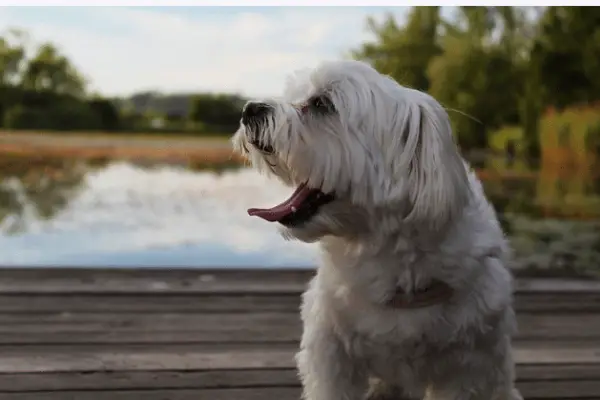11 Potential Signs of Aggression in Dogs With Tips

Today, let’s dive into a topic that every responsible dog owner should be aware of: signs of aggression in our furry friends.
In this blog post, we’ll explore the subtle cues that indicate when our beloved pups may be feeling a little less than friendly.
Let’s get started…
Signs of Aggression in Dogs
Signs of aggression in dogs include growling, baring teeth, lunging, raised hackles, staring, and rigid body posture.
It is important to recognize these signs early on and seek professional help to address the underlying causes of aggression in dogs.
Let’s break it down further…
The following are some common signs of aggression in dogs:
1. Bared Teeth or Curled Lips
Bared teeth or curled lips in dogs are often signs of aggression, these behaviors indicate that the dog is feeling threatened or defensive.
When faced with such a situation, it is important to remain calm and avoid any sudden movements that may escalate the aggression.
Do not approach the dog or make direct eye contact, as this can be seen as a challenge. Instead, slowly and calmly back away from the dog while maintaining a safe distance.
If the dog’s behavior persists or becomes more intense, it is advisable to seek assistance from a professional dog trainer or animal behaviorist.
2. Lunging
Lunging in dogs is a sign of aggression, which is often a result of fear, frustration, or territoriality.
To address such a situation, it is important to first identify the underlying cause of the aggression.
Once the cause is understood, implementing positive reinforcement training techniques can help modify the behavior.
This may involve desensitizing the dog to triggers that provoke aggression and rewarding calm behavior.
Seeking the help of a professional dog trainer or behaviorist can provide guidance and tailored strategies to address the specific aggression issue.
3. Snapping or Biting
Snapping or biting in dogs is a sign of aggression, which should be taken seriously.
It is essential to identify the underlying cause of the aggression, whether it is fear, resource guarding, or territorial behavior.
Seeking the help of a professional dog trainer or behaviorist is recommended to address the situation effectively. They can provide guidance on behavior modification techniques and create a customized training plan for the dog.
Additionally, it is crucial to ensure the safety of all individuals involved by implementing management strategies such as using muzzles or barriers until the behavior is resolved.
4. Growling
Growling in dogs is often considered a sign of aggression. It is a vocalization that dogs use to communicate their discomfort or warning to others.
To address such a situation, it is important to first understand the underlying cause of the growling. It could be triggered by fear, resource guarding, or territorial behavior.
Once the cause is identified, appropriate training methods should be implemented, such as positive reinforcement and desensitization techniques.
5. An Intense Stare
An intense stare in dogs is a sign of aggression. When a dog stares intensely, it may indicate that they are feeling threatened or preparing to attack.
To address such a situation, it is important to remain calm and avoid direct eye contact with the dog. Slowly back away without turning your back to the dog, and give them space.
If the dog continues to show signs of aggression, it is best to seek professional help from a qualified dog trainer or behaviorist.
6. Raised Hackles
Raised hackle in dogs is a sign of aggression or heightened arousal. When a dog’s hackles are raised, it typically indicates that they are feeling threatened or uncomfortable.
To address such a situation, it is important to remain calm and avoid escalating the dog’s aggression. Give the dog space and avoid direct eye contact.
If possible, remove the dog from the triggering situation and consult with a professional dog trainer or behaviorist for further guidance on managing and addressing the aggression.
7. Rigid Body Posture
Rigid body posture in dogs is a sign of aggression. When a dog exhibits a stiff and tense body posture, with a straight tail, raised hackles, and a fixed stare, it indicates that the dog is feeling threatened or defensive.
To address this situation, it’s important to remain calm and avoid any sudden movements that may escalate the dog’s aggression.
Give the dog space and try to remove any potential triggers or sources of stress.
8. Raised Tail
A raised tail in dogs can be a sign of aggression. When a dog raises its tail high and stiff, it indicates a dominant and potentially aggressive behavior.
To address such a situation, it is important to stay calm and avoid any sudden movements that may provoke the dog further. It is recommended to give the dog space and avoid direct eye contact.
If the aggression persists or becomes a recurring issue, consulting with a professional dog trainer or behaviorist is advisable to address the underlying causes and implement appropriate training techniques.
9. Hair Standing Up
When a dog’s hair stands up, it is often a sign of aggression. This behavior, known as piloerection, occurs when the dog’s fur bristles and stands on end.
It is an instinctual response that signals the dog’s readiness to defend itself or assert dominance.
To address such a situation, it is important to remain calm and avoid any sudden movements or actions that may escalate the dog’s aggression.
It is best to give the dog space and avoid direct eye contact. If the behavior persists or becomes a recurring issue, it is recommended to seek professional help from a qualified dog behaviorist or trainer.
10. Ears That are Laid Back Flat or Standing Straight Up
Ears that are either laid back flat or standing straight up in dogs are a sign of aggression.
When a dog’s ears are laid back flat, it indicates fear or submission, while ears standing straight up can signal alertness or aggression.
To address such a situation, it is essential to assess the overall body language of the dog, including posture and facial expressions, to determine the cause of such aggression and address it.
11. Avoiding Eye Contact
Avoiding eye contact can indeed be a sign of aggression in dogs. When a dog avoids eye contact, it may be indicating that it feels threatened or uncomfortable.
To address this situation, it is important to respect the dog’s boundaries and give it space.
Avoid direct eye contact and instead, try to approach the dog calmly and slowly.
Offering treats or engaging in non-threatening activities can help build trust and alleviate the dog’s aggression.
Causes of Aggression in Dogs
Aggression in dogs can have various underlying causes. One common cause is fear or anxiety, where a dog may become aggressive as a defensive response.
Another cause is territorial aggression, where dogs perceive their environment as their territory and display aggression towards perceived intruders.
Resource guarding can also lead to aggression, where dogs become possessive and aggressive over their food, toys, or other valuable items.
Lastly, inadequate socialization or past traumatic experiences can contribute to aggression in dogs, as they may lack the necessary skills to interact appropriately with other dogs or humans.
Read more about dog aggression towards other dogs.
Addressing Aggression in Dogs
Addressing aggression in dogs is crucial for their well-being and the safety of those around them. Here are some common ways to address aggression in dogs:
- Positive Reinforcement Training: This method focuses on rewarding desired behaviors and using positive reinforcement to encourage calm and non-aggressive behavior. It involves teaching the dog alternative behaviors and rewarding them when they display those behaviors instead of aggression.
- Behavior Modification: Behavior modification techniques involve identifying triggers or situations that lead to aggression and gradually exposing the dog to them in a controlled and positive way. This helps desensitize the dog and change their emotional response to those triggers.
- Socialization: Proper socialization from an early age can help prevent aggression in dogs. Exposing them to various people, animals, and environments in a positive and controlled manner can help them develop positive associations and reduce fear or aggression toward unfamiliar stimuli.
- Environmental Management: Creating a safe and controlled environment for the dog is important to reduce opportunities for aggression. This may involve managing the dog’s access to resources, such as food and toys, and ensuring they have a comfortable and secure space.
- Medical Evaluation: Aggression in dogs can sometimes be caused or influenced by underlying medical conditions. It is important to have the dog evaluated by a veterinarian to rule out any physical or medical issues that may be contributing to the aggression.
- Professional Help: Seeking guidance from a professional, such as a certified dog trainer, behaviorist, or veterinarian, is often necessary when dealing with aggression in dogs. They can provide personalized advice and develop a behavior modification plan tailored to the dog’s specific needs.
- Medication: In some cases, medication may be prescribed by a veterinarian to help manage aggression in dogs. Medication can help reduce anxiety or other underlying issues that contribute to aggressive behavior. It is important to work closely with a veterinarian to determine if medication is appropriate and to monitor the dog’s progress.
- Exercise and Mental Stimulation: Regular exercise and mental stimulation are crucial for a dog’s overall well-being and can help reduce aggression. Providing outlets for physical and mental energy can help prevent frustration and redirect aggressive behaviors.
- Consistency and Structure: Establishing consistent rules, boundaries, and routines for the dog can help them feel secure and reduce anxiety or stress that may contribute to aggression. Clear communication and consistent training methods are important for addressing and preventing aggression in dogs.
It is important to note that addressing aggression in dogs requires patience, time, and consistent effort. Each dog is unique, and the approach may vary depending on the underlying causes and individual needs. Seeking professional guidance is recommended for the best results.
Read more about common behavior concerns in dogs.
Frequently Asked Questions
How can I tell if my dog is displaying aggressive behavior?
There are several signs to look out for when determining if your dog is being aggressive. Common indicators include growling, snarling, baring teeth, lunging, or snapping. It’s important to note that aggressive behavior can manifest differently in each dog, so it’s crucial to pay attention to any changes in their body language and overall demeanor.
What are some potential causes of aggression in dogs?
Aggression in dogs can stem from various factors, including fear, territoriality, resource guarding, lack of socialization, or even underlying medical conditions. Identifying the root cause is essential in addressing and managing the aggression effectively.
Are certain dog breeds more prone to aggression?
While it’s important not to generalize, some dog breeds may have a predisposition towards certain behaviors, including aggression. However, it’s crucial to remember that breed alone does not determine aggression. Factors such as training, socialization, and individual personality play significant roles in a dog’s behavior.
Can aggressive behavior in dogs be treated or managed?
Yes, with proper training, behavior modification techniques, and the guidance of a professional dog behaviorist, aggression in dogs can often be managed and improved. It’s crucial to seek professional help to ensure the safety of both your dog and those around them.
How can I prevent my dog from becoming aggressive?
Early socialization, positive reinforcement training methods, and providing a loving and stable environment are key to preventing aggression in dogs. Regular exercise, mental stimulation, and clear boundaries also contribute to a well-rounded and balanced canine companion.
Is it possible to rehabilitate an aggressive dog?
In many cases, with the right approach, dedicated training, and the assistance of experienced professionals, aggressive dogs can be rehabilitated. However, it’s important to note that each case is unique, and the success of rehabilitation depends on various factors, including the severity of the aggression and the commitment of the owner.
Read more about identifying a poorly socialized dog.
Conclusion
In conclusion, recognizing signs of aggression in dogs is crucial for their well-being and the safety of those around them.
Remember to pay attention to body language, growling, and snapping as potential warning signs.
By understanding these cues, we can take proactive steps to address aggression and promote a harmonious relationship with our furry companions.

![Food Aggression in Dogs [Causes, Signs & Fix] Food Aggression in Dogs](https://petcreeks.com/wp-content/uploads/2023/10/pexels-vlada-karpovich-6801934.jpg)
![New Puppy Crying In Crate At Night [Tips] New Puppy Crying In Crate At Night](https://petcreeks.com/wp-content/uploads/2023/02/New-Puppy-Crying-In-Crate-At-Night-768x555.jpg)


![How To Discipline a Beagle [10 Insights] How To Discipline a Beagle](https://petcreeks.com/wp-content/uploads/2023/05/How-To-Discipline-a-Beagle-768x555.jpg)
